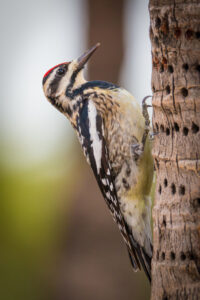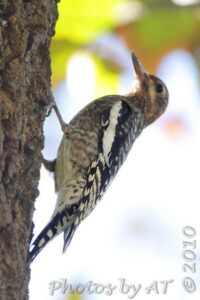Yellow-bellied Sapsucker, Sphyrapicus varius
Bill Rowe
First, a clarification: the Yellow-bellied Sapsucker is indeed a real bird, not a joke. In the Midwest, it’s one of our seven regular woodpeckers, and while it is rather quiet and retiring, you can see some every year if you keep alert for them. (One way is to listen for their fussy “mew” call, like a kitten). This sapsucker is among the many species of birds that nest to our north, in Canada and the northeastern states, and come through both spring and fall on migration, with some of them sticking around through the midwestern winter. Out west, it has two close relatives that actually used to be considered part of the same species, until enough evidence accumulated to convince ornithologists that they should be treated as separate species (Red-naped and Red-breasted Sapsuckers). Thus, if you look at a bird book published before 1985, you will see only Yellow-bellied, with a continent-wide breeding range; by the late ‘80s, the books had caught up with the change. This kind of “split” has occurred with many birds, as knowledge from the field (birds’ distribution and behavior) and the lab (their genetic makeup) keeps increasing. Sapsuckers do indeed eat the sap of various trees, preferring those with higher sugar content; it often forms a large part of their diet, augmented by fruit and insects and even the inner bark. To reach it, the sapsucker drills a profusion of small holes around tree trunks in irregular rows or rings; when you see this, even in your yard, it’s a sure sign of who’s been at work. According to recent sources, there is not much evidence that sapsuckers actually kill trees this way.
IDENTIFICATION: Easy with a good look. In any plumage, look for a bold vertical white stripe down the wing; no other woodpecker shows that (see all photos). Adult males have a red cap and throat (above); females a white throat; and juveniles a duller, more obscure head pattern, which lasts well into the fall before they begin to molt into their first adult plumage.
ST. LOUIS STATUS: Never really numerous, but moderately common during March-April and October-November; then uncommon in winter in the woods and also in parks and suburbs. You may have one near your house right now without realizing it!
Learn more and listen to the calls and the drumming (notice the irregular “stuttering” pattern) of Yellow-bellied Sapsuckers here.
Adult female
Juvenile
Photo Credit: Al Smith






